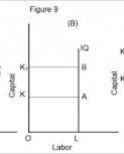
Business, 14.04.2020 16:57 Daddysgirl2019
With capital on the vertical axis and labor on the horizontal axis, vertical isoquants imply that Question 18 options: A) capital and labor must be used together in a fixed proportion. B) capital and labor are perfect substitutes. C) capital is not productive. D) labor is not productive.

Answers: 2


Other questions on the subject: Business

Business, 21.06.2019 18:20, kierafisher05
James sebenius, in his harvard business review article: six habits of merely effective negotiators, identifies six mistakes that negotiators make that keep them from solving the right problem. identify which mistake is being described. striving for a “win-win” agreement results in differences being overlooked that may result in joint gains.
Answers: 2

Business, 22.06.2019 07:50, sis212
Connors academy reported inventory in the 2017 year-end balance sheet, using the fifo method, as $154,000. in 2018, the company decided to change its inventory method to lifo. if the company had used the lifo method in 2017, the company estimates that ending inventory would have been in the range $130,000-$135,000. what adjustment would connors make for this change in inventory method?
Answers: 1

Business, 22.06.2019 11:10, henryzx900
How much are you willing to pay for a zero that matures in 10 years, has a face value of $1,000 and your required rate of return is 7%? round to the nearest cent. do not include a dollar sign in your answer. (i. e. if your answer is $432.51, then type 432.51 without $ sign)
Answers: 1

Business, 22.06.2019 17:40, lukecoupland4401
Solomon chemical company makes three products, b7, k6, and x9, which are joint products from the same materials. in a standard batch of 320,000 pounds of raw materials, the company generates 70,000 pounds of b7, 150,000 pounds of k6, and 100,000 pounds of x9. a standard batch costs $3,840,000 to produce. the sales prices per pound are $10, $14, and $20 for b7, k6, and x9, respectively. (a) allocate the joint product cost among the three final products using weight as the allocation base. (b) allocate the joint product cost among the three final products using market value as the allocation base. (c) allocate the joint product cost among the three final products using weight as the allocation base.
Answers: 3
You know the right answer?
With capital on the vertical axis and labor on the horizontal axis, vertical isoquants imply that Qu...
Questions in other subjects:

Mathematics, 10.12.2019 23:31



Biology, 10.12.2019 23:31





English, 10.12.2019 23:31





